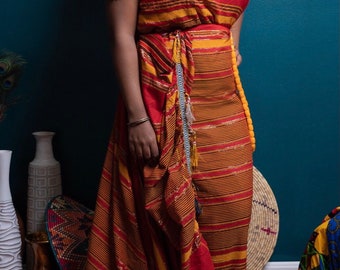Somalia needs to protect Alindi, Oromos and other African ethnic groups are claiming it as theirs and renaming it.

SOMALI HISTORY OF ALINDI FABRICS
'The Weaver's Song'
SOMALI HISTORY OF ALINDI FABRICS
'The Weaver's Song'
'In 1330, the Arab traveler Ibn Battuta wrote of Somalia's thriving cloth industry: "In this place [Benaadir] are manufactured the unequalled woven fabrics named after it, which are exported from there to Egypt and elsewhere." A crossroads between Africa and the Middle East, Somalia was a pivot-point of trade, linking ports from Egypt to India. Her capital of Mogadishu sits on the Indian Ocean, 1,300 kilometers (800 miles) from the Gulf of Aden and equidistant from Cairo, Baghdad and the trading cities of India's southwestern coast. It was once a major entrepôt of the trade in spices, aromatic gums, ivory and textiles... The fields of the Jubaland Plain were polka-dotted with cotton plants, and Somalis produced over 350,000 pieces of cloth annually from the fertile ground...
Using locally grown vegetable dyes such as saffron and imported dyed yarns from India and Pakistan, Somali weavers began in the late 1950's to weave brilliant reds, blues, yellows, blacks, and purples into their futas and guntinos, giving their people traditional cloths to use for marriages, funerals, furniture, war dancing, and everyday farming. Weavers invented dozens of patterns with names like "teeth" and "goats in the sand dunes" that have become standards and today are worn in major ceremonies and the religious festivities that keep the national spirit of this Islamic stronghold alive...
The weaver first takes the dyed yarn in 24 batches of eight-meter (26-foot) lengths, each tied together and marked with spittle and kohl. He dunks them into a sizing of flour and water to make the fibers stiff and strong. Then, in a stretching method called darisi, the threads are wrapped from one strategically placed vertical stick in the building to another, and left to dry like a long L-shaped blanket. When the yarn has dried, it is wound onto a wooden spindle called the furfure, then unwound and tied into the heddle loops, following the color pattern indicated by loose strings on the bamboo heddle. The weaver affixes the heddle to the loom and stretches the threads of the new warp out behind the loom to a single iron hook set in the floor seven and a half to eight meters (24 to 26 feet) away. There all the warp threads are gathered into one fat knot, tied to a length of rope, and attached to the hook. The other end of the rope is led back to the weaver's seat. As weaving progresses and cloth is wound onto the cloth beam, the warp is fed toward the loom, anchoring it to the hook each time with a new knot farther down the rope... To meet the challenge of changing fashion they are helping to change the way women wear their cloth... Steadfast and adaptable, he shuttles weft into warp with whatever thread he has available, and keeps his feet firmly in the pit beneath his loom, whether it is in his own house or in a cooperative workshop. The thread does come, alham-dulillah - praise God. His loom remains full and his family fed...
"It would probably not be entirely inappropriate to repeat earlier concerns that the weavers of futa Benaadiri face an uncertain future. Futa Benaadiri is no longer an inexpensive alternative to imported cloths and as a prestige textile it faces competition from Tanzanian kitenge and similar stuffs. [But] its ability to endure for more than seven centuries, and particularly to make radical adjustments that historical circumstances have forced upon it over the past century, suggest strongly that it will continue to survive.' | An excerpt | © Pages 8-11 of the September/October 1989 print edition of SAW.



